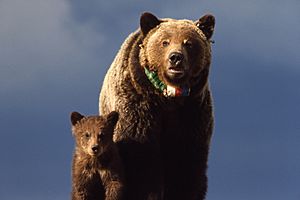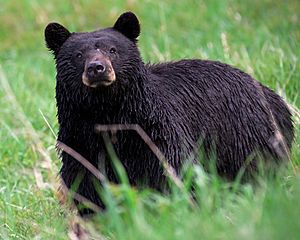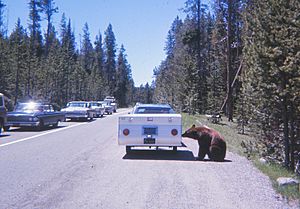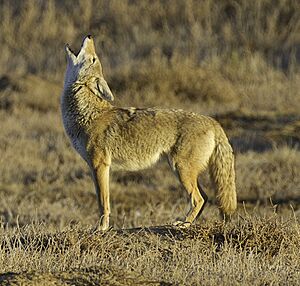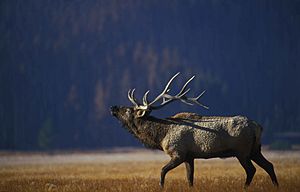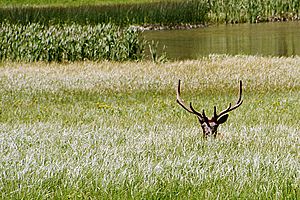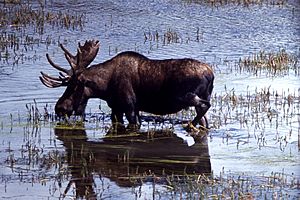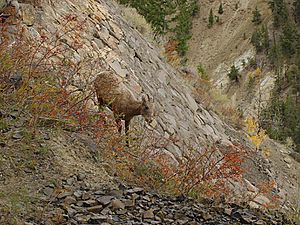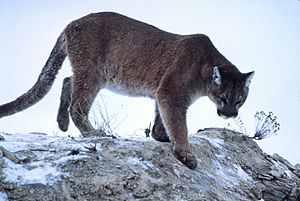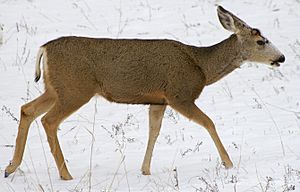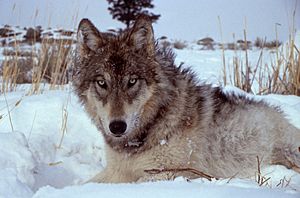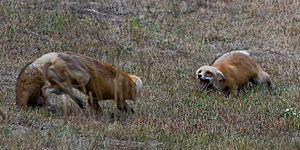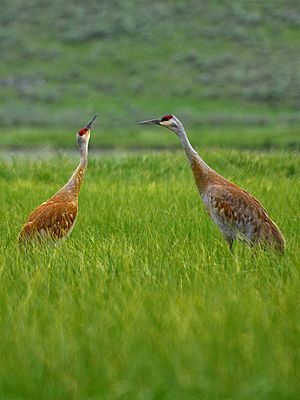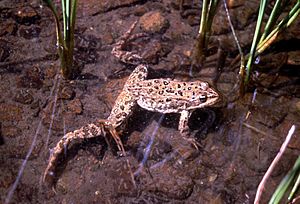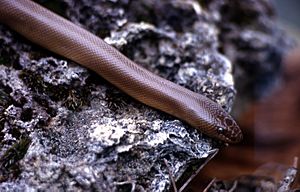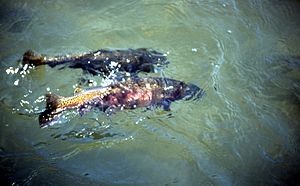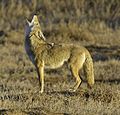List of animals of Yellowstone facts for kids
Yellowstone National Park in the northwest United States is a special place. It's home to many different kinds of animals, like mammals, birds, fish, reptiles, and amphibians. Many of these animals travel around the larger Greater Yellowstone Ecosystem. Seeing these amazing creatures is a big reason why people visit the park.
Contents
- Large Mammals of Yellowstone
- American Bison: Yellowstone's Giants
- Bears: Grizzlies and Black Bears
- Bobcats: Elusive Hunters
- Canada Lynx: A Rare Sight
- Coyotes: Smart Survivors
- Elk: Yellowstone's Most Common Large Mammal
- Moose: The Largest Deer
- Mountain Goats: Non-Native Residents
- Bighorn Sheep: Mountain Climbers
- Mountain Lions: Yellowstone's Big Cats
- Deer: Mule and White-tailed
- Gray Wolf: Return of a Predator
- Red Fox: Forest Dwellers
- Small Mammals of Yellowstone
- Birds of Yellowstone
- Amphibians and Reptiles of Yellowstone
- Fish of Yellowstone
- Images for kids
- See also
Large Mammals of Yellowstone
Yellowstone National Park is famous for its large mammals. These include huge bison, powerful bears, and graceful elk.
American Bison: Yellowstone's Giants
Bison are the biggest grazing mammals in Yellowstone. They are plant-eaters, munching on grasses and other plants in meadows and even high up in the forests. Male bison, called bulls, can weigh over 1,800 pounds (816 kg). Females, called cows, average about 1,300 pounds (590 kg). Both can stand about six feet (1.8 meters) tall at the shoulder. Even though they are huge, bison can move very fast if they need to protect their young or feel threatened.
Bison usually have one calf in April or May. They can live for 20 to 25 years in the wild. Yellowstone is the only place in the lower 48 states where wild American bison have lived continuously since ancient times. In the early 1900s, there were very few bison left. To save them from extinction, the park brought in 21 bison from private herds. Over time, with protection from poaching, the bison population grew. Today, there are about 4,000 bison in the park.
Bison are always on the move, looking for food. In summer, they graze on the park's high plateaus. In winter, they use their strong heads to push snow aside and find food. They often stay in warmer areas near geysers when the snow is deep.
Bears: Grizzlies and Black Bears
Yellowstone is home to two types of bears: the grizzly bear (a type of brown bear) and the black bear. In 2017, there were about 718 grizzly bears and 575 black bears in the Greater Yellowstone area.
Bears often eat Yellowstone cutthroat trout when the fish are spawning in streams. These fish are full of protein and fat, which helps bears regain weight after winter and helps mother bears feed their cubs. Grizzly bears usually live about 22 years, and black bears live about 17 years.
When gray wolves were brought back to Yellowstone, people wondered how it would affect the bears. Bears and wolves have lived together in North America for a long time.
Years ago, bears in Yellowstone were often seen along roads and in developed areas. This was because people fed them or left food out. While visitors enjoyed seeing them, this led to many bear-caused injuries to humans. From 1930 to 1969, about 48 people were injured by bears each year. Some grizzly bears have caused fatalities in the park since the 1970s.
In 1970, park officials started a special bear management program. The goal was to help bears find food naturally and reduce injuries to people. Feeding bears became strictly against the rules. At first, many bears struggled to find food and became more aggressive. Over a hundred grizzly bears had to be put down, which put the park's bear population in danger. In 1975, the grizzly bear was listed as a threatened species in the lower 48 states.
Over many years, bears learned to hunt and find food on their own. Their population slowly grew. In 2007, the grizzly bear was removed from the endangered species list. By 2017, the Yellowstone grizzly bear population had grown to at least 640.
From 1980 to 2002, 32 people were injured by bears, out of over 62 million visitors. The chance of being injured by a bear in the park is very low, about one in 1.9 million. Since 1872, eight known bear-caused human fatalities have occurred in the park. Seven of these involved grizzlies.
Bobcats: Elusive Hunters
Bobcats are wild cats that were once common in Yellowstone. Since 1960, there have been 9 to 14 sightings reported each decade. They have been seen all over the park, mostly in the northern half, and in all seasons.
Bobcats are shy animals that usually live alone and hunt at night. They are hard to spot. No special studies have been done on bobcats in Yellowstone to find out how many there are or where they live.
Bobcats are very good at adapting to changes in their environment. Yellowstone has many rocky areas, canyons, and forests that are good for bobcats. These areas offer shelter and plenty of food like rodents, rabbits, birds, and other small animals. Bobcats can also hunt young deer. Bobcats usually live for about 7 years. If you see a bobcat or its tracks, it's helpful to tell a park ranger or visitor center.
Canada Lynx: A Rare Sight
The Canada lynx is a threatened species under the Endangered Species Act. Biologists believe that lynx have lived in Yellowstone since the park was created in 1872. A study finished in 2005 found that a small group of lynx lives in the park. However, they are very rarely seen by people or even by biologists.
Coyotes: Smart Survivors
Yellowstone's coyotes are among the largest in the United States, usually weighing about 30 pounds (13–14 kg). Some can weigh around 40 pounds (18 kg).
Coyotes typically live for about 6 years, though one Yellowstone coyote lived for over 24 years. Coyotes are common predators in the park. They are often seen alone or in groups, hunting small mammals in the open valleys. They can also be found in forests and near hot springs. When they hunt together, they can even take down larger prey.
When wolves were brought back in 1995, the coyote population decreased. However, coyotes that remain often scavenge food from wolf kills. Park biologists continue to study how wolves and coyotes interact.
Sometimes, coyotes lose their fear of humans, especially if people feed them or leave food scraps. This can be dangerous for both people and coyotes. There have been a few cases of coyotes acting aggressively towards humans in the park.
Elk: Yellowstone's Most Common Large Mammal
Elk, also called wapiti, are the most common large mammal in Yellowstone. They have lived here for at least 1,000 years. When Yellowstone National Park was created in 1872, many large animals were being hunted. After 1886, when the United States Army came to protect the park, elk numbers started to grow.
However, in recent years, Yellowstone's elk population has dropped. The Northern Herd, which stays in the park during winter, went from nearly 20,000 animals in 1994 to less than 4,000 in 2013. Scientists think this decline is linked to a decrease in cutthroat trout in Yellowstone Lake, caused by invasive lake trout. With fewer fish to eat, grizzly bears started eating more elk calves, which led to fewer elk.
More than 30,000 elk from 7-8 different herds spend their summers in Yellowstone. About 15,000 to 22,000 elk stay in the park for the winter. Elk are the second largest member of the deer family, after moose. Adult males, called bulls, can weigh over 700 pounds (320 kg). Females, called cows, average 500-525 pounds (225–240 kg). Elk usually live about 15 years in the wild.
Bulls grow new antlers every year. A mature bull's antlers can have 6 to 8 points on each side and weigh over 30 pounds. They shed their antlers in March or April, and new ones start growing in May. By August, the antlers are fully grown, and the bulls rub off the velvet covering them. This prepares them for the autumn mating season, called the rut. During this time, a bull might gather 20-30 cows into his group, often fighting other males to show dominance. By November, the mating season ends, and elk move to their winter homes. Calves, weighing 25-40 pounds, are born in late May or early June.
Moose: The Largest Deer
Moose are the largest members of the deer family. They were very rare in northwest Wyoming when Yellowstone National Park was created in 1872. Protection from hunting and wolf control programs helped their numbers grow. However, preventing forest fires was also important, as moose in Yellowstone rely on mature fir forests for winter survival.
In the late 1980s, there were fewer than 1,000 moose in the park. The number of moose calves has been decreasing since the large fires of 1988. After the fires, many older moose died, likely due to less food and a harsh winter. The fires also forced some moose into less suitable habitats. Moose usually live up to 20 years in the wild.
Moose are often seen in the park's southwest corner, along the Bechler and Fall Rivers. They also live near Yellowstone Lake, and in the Soda Butte Creek, Pelican Creek, Lewis River, and Gallatin River areas.
Mountain Goats: Non-Native Residents
Mountain goats are not originally from Yellowstone. They were brought to the Absaroka Range in Montana in the 1940s and later moved into the park. By the 1990s, they had established breeding groups in the park's northwest and northeast areas. In 2008, there were an estimated 175–225 goats in and near the park.
Having a non-native species like mountain goats has raised concerns. They might negatively affect the park's high-altitude habitats and compete with bighorn sheep, which share some of the same areas. Mountain goats generally live for 15 years in the wild.
Bighorn Sheep: Mountain Climbers
Bighorn sheep were once very common in the western United States. They were an important food source for people. The "Sheep eaters", a group of Shoshone people, lived in Yellowstone year-round until 1880. They mainly ate bighorn sheep and even made their bows from sheep horns. By 1900, hunting had greatly reduced bighorn numbers.
In 1897, there were about 100-150 bighorns in the park. By 1912, despite a disease from domestic sheep, their numbers grew to over 200. Visitors could often spot them near Mount Everts or Mount Washburn. In winter, small groups of sheep were seen daily between Mammoth and Gardiner. Bighorn sheep usually live 10–15 years in the wild.
Mountain Lions: Yellowstone's Big Cats
The mountain lion, also called a cougar, is the largest member of the cat family living in Yellowstone. Males can weigh up to 200 pounds (90 kg), though Yellowstone lions are usually 140 to 160 pounds (65–70 kg). Females weigh around 100 pounds (45 kg). Mountain lions can have 2 to 3 kittens at any time of year, but most are born in summer and fall. Sadly, only about half of the kittens survive their first year.
The current mountain lion population in Yellowstone is estimated to be 18-24 animals and is thought to be growing. Mountain lions were greatly reduced by predator control efforts in the early 1900s. Between 1904 and 1925, 121 lions were removed from the park. At that time, only about 12 were thought to remain.
Reports of mountain lions in Yellowstone have increased since the 1930s. This is partly because more visitors are in the park and records are better kept. In 1987, the first study of mountain lions in Yellowstone began. This research looked at their population, how they use their habitat, and their role as predators. While mountain lions have sometimes caused harm to humans in other areas, no documented lion-human confrontations have happened in Yellowstone. Mountain lions usually live for about 12 years in the wild.
Deer: Mule and White-tailed
The mule deer is a type of deer found in the western half of North America. It gets its name from its large, mule-like ears. In Yellowstone, mule deer live in forests, grasslands, and shrublands.
The white-tailed deer lives in certain areas of the central and northern Great Plains and in the lower foothills of the northern Rocky Mountains. It sometimes visits these habitats in the Yellowstone region. Both mule and white-tailed deer usually live for 10 to 15 years in the wild.
Gray Wolf: Return of a Predator
Northern Rocky Mountain wolves were native to Yellowstone when the park was created in 1872. However, predator control programs in the early 1900s led to many wolves being killed. By the 1940s, wolf packs were rarely seen, and by the 1970s, there was no evidence of wolves in Yellowstone.
In 1995, Canadian grey wolves were brought back to Yellowstone. This brought wolves back to land where they once thrived. They now live in several packs, including the Slough Creek, Yellowstone Delta, and Leopold packs. At first, the wolves had to "re-learn" how to hunt bison, as they were used to elk in Canada. However, elk remain their main prey. Wolves in Yellowstone can live up to 10 years in the wild, but 6 to 8 years is more common.
The United States Fish and Wildlife Service provides regular updates on the wolves in the Rocky Mountain region, including Yellowstone. At the end of 2011, there were at least 98 wolves in ten packs and two lone wolves in the park.
Red Fox: Forest Dwellers
A type of Red fox lives in Yellowstone and the Greater Yellowstone Ecosystem. These foxes are not very common because of predators like coyotes and competition for food. They are most often found in the park's forested areas.
Small Mammals of Yellowstone
Yellowstone National Park is home to at least 50 different kinds of small mammals. These include four common types of bats: big brown bat, little brown bat, long-legged bat, and silver-haired bat.
Other common small mammals are squirrels, rabbits, skunks, raccoons, badgers, otters, beavers, porcupines, voles, mice, and shrews. Many of these are nocturnal, meaning they are active at night, so visitors rarely see them. The Uinta ground squirrel, least chipmunk, golden-mantled ground squirrel, and American red squirrel are often seen during the day.
Weasel species, including the North American river otter, are common in the park. North American beavers were almost trapped out of the park area before it was created. By 1998, beaver populations were growing again. An estimated 500 beavers lived in the park, with the most in the Bechler River and Fall River region, the Yellowstone River delta, and the lower Madison River.
Birds of Yellowstone
Since Yellowstone National Park was created in 1872, 318 different species of birds have been seen within its borders. Even though Yellowstone's high altitude and cold winters make it less ideal for some birds, it has many interesting species that visitors enjoy seeing every year.
The park has good populations of bald eagles, trumpeter swans, common loons, ospreys, American white pelicans, and sandhill cranes. The park's many rivers, lakes, and wetlands are summer homes for large numbers of waterfowl. The forests and meadows host many different kinds of warblers, sparrows, and other passerine birds (perching birds).
Amphibians and Reptiles of Yellowstone
Yellowstone is home to four species of amphibians. The park's cool, dry conditions and past glacial activity likely explain why there aren't more amphibians here.
While no Yellowstone reptile or amphibian species are currently listed as threatened or endangered, some, like the boreal toad, are thought to be decreasing in the western United States. Park scientists are studying these populations to see if they are declining in Yellowstone. In 2014, a group of plains spadefoot toads was found in the park. Other common species include the boreal chorus frog, columbian spotted frog, and the blotched tiger salamander.
The cool, dry conditions also limit Yellowstone's reptiles to six species. The number of these reptile populations is not fully known. The reptile species found in the park are the prairie rattlesnake, bullsnake, valley garter snake, wandering garter snake, rubber boa, and sagebrush lizard.
In 1991, park staff started working with researchers to study more park habitats for reptiles and amphibians. This led to setting up long-term monitoring sites. The park's natural state and the information gathered can help scientists understand why some species of toads and frogs are declining in the western United States. Factors like drought, pollution, disease, predation, habitat loss, and introduced fish or other non-native species might be causing these declines.
Fish of Yellowstone
Yellowstone Lake has the largest inland population of cutthroat trout in the world. It's a very important place for the native Yellowstone cutthroat trout in the Yellowstone ecosystem. Each spring, these trout swim from the lake into its smaller streams to spawn (lay eggs).
Yellowstone cutthroat trout numbers decreased in the second half of the 20th century. This was due to too much fishing, competition with non-native fishes, and too many eggs being collected. Their populations grew back after fishing rules changed in the 1970s to "catch-and-release-only." However, new and aggressive non-native fish are now threatening these native trout.
Non-native lake trout, which are effective fish predators, were found in Yellowstone Lake in 1994. Where lake trout are introduced, cutthroat trout populations usually decline or disappear. The National Park Service has worked hard to control lake trout, removing thousands of them from Yellowstone Lake since 1994. Still, the number of Yellowstone cutthroat trout counted in the lake each fall has been lower in recent years than ever before in the 25-year history of monitoring. Whirling disease, which affects trout, was also found in Yellowstone Lake in 1998. It's not clear which of these two non-native threats has caused more decline, but both are definitely having an impact.
Yellowstone cutthroat trout have declined across the western United States. They are now considered a "Species of Special Concern." Yellowstone National Park contains about 91% of the current range of Yellowstone cutthroat trout and 85% of their historical lake habitat. This means the park is vital for the survival of this species.
Other native sport fish, like westslope cutthroat trout and Montana grayling, have been under catch-and-release-only fishing rules since 1973. Recently, mountain whitefish were also placed under these rules, giving them the same protection as other native sport fish in the park.
Images for kids
See also
- List of animals of the Rocky Mountains


